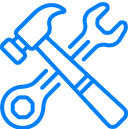Table of Contents
HVAC contractors compete for homeowners who need immediate heating and cooling solutions, making pay-per-click advertising the fastest way to capture these high-intent searchers. When someone’s furnace fails on a winter night or their air conditioner breaks during a heat wave, they turn to Google for emergency service providers, creating opportunities for HVAC businesses to connect with customers at the exact moment they’re ready to buy. PPC campaigns put your company at the top of search results for location-specific queries like “furnace repair near me” or “emergency AC service,” bypassing the months-long wait that comes with organic search engine optimization.

Components of Successful HVAC PPC Campaigns
HVAC PPC ads and campaigns succeed when each component works together to capture searchers at different stages of need, from emergency breakdowns to planned equipment upgrades. Account organization separates heating services from cooling services, emergency calls from scheduled maintenance, and residential customers from commercial accounts, creating focused ad groups that speak directly to specific customer problems.
Quality Score and Ad Ranking Factors on HVAC PPC Performance
Google assigns quality scores based on how well your ads match what searchers actually want, directly affecting both your ad position and what you pay per click. The platform examines three factors: whether your keywords match your ad copy, whether your landing page delivers what the ad format promises, and whether people actually click your ads when they see them. HVAC marketing contractors boost their scores by building ad groups around single services like “water heater repair” instead of mixing all services together, writing ads that include the city name and specific service, and sending clicks to pages about that exact service rather than a general homepage that makes visitors hunt for information.
Negative Keywords in HVAC PPC Campaign Success
Negative keywords block your ads from appearing when people search for things that waste your budget and attract the wrong visitors. Building a solid negative keyword list protects your ad spend from irrelevant clicks and focuses your campaigns on actual customers:

DIY Terms
Blocks searches from homeowners trying to fix equipment themselves instead of hiring professionals

Employment Searches
Prevents job seekers searching “HVAC careers” or “technician jobs” from clicking your service ads

Free Content
Stops people looking for “free HVAC quotes” or “free troubleshooting guides” who aren’t ready to pay

Geographic Exclusions
Block cities and regions outside your service area so you only pay for reachable customers

Training Keywords
Eliminates clicks from students researching “HVAC school” or “certification programs
Target Audience Research in HVAC Advertising Campaigns
Residential and commercial HVAC customers search differently, respond to different messages, and buy on completely different timelines, making audience research the foundation of profitable campaign targeting. Homeowners usually need service right now—their heat stopped working or their AC unit died—so they respond to ads promising fast response times and emergency availability. Commercial property managers think months ahead, planning maintenance schedules and budget approvals, which means they want to see credentials, certifications, and case studies showing you can handle large buildings without disrupting business operations. Weather drives search volume more than anything else, with furnace searches spiking when temperatures drop and air conditioning queries flooding in during the first hot week of spring, requiring budget shifts that match seasonal demand patterns.
Structuring Search Ads and Display Campaigns for HVAC Contractors
Search ads catch people actively looking for HVAC help right now, while display ads keep your company visible to homeowners who might need service later when their equipment fails. Search campaigns work best when organized by service type and urgency level—emergency repair ads need different messaging than routine maintenance ads, and residential customers respond to different appeals than commercial property managers. Display campaigns complement search by showing your trucks and technicians to local homeowners browsing other websites, building recognition that pays off when their furnace breaks down months later:
Local Service Ads for Residential HVAC Companies
Local service ads place HVAC contractors at the top of Google with verified badges and customer reviews that build immediate trust with homeowners. These ads operate on a pay-per-lead model rather than pay-per-click, connecting contractors directly with customers ready to book service:

Google Guaranteed Badge
Provides instant credibility through Google’s background check and license verification process

Pay-Per-Lead Pricing
Charges only when customers actually contact you instead of paying for every click

Review Integration
Displays customer ratings and feedback directly in search results to influence purchase decisions

Direct Booking Options
Allows customers to schedule appointments without visiting your website

Local Market Focus
Targets searchers specifically in your service area with location-based filtering
Broad Keywords for Commercial HVAC Businesses
Commercial HVAC contracts involve multiple decision-makers, longer approval processes, and technical specifications that require broader keyword targeting to capture the full range of business searches. Facility managers might search for “preventive maintenance agreements,” property owners look up “energy-efficient HVAC upgrades,” and procurement teams research “commercial rooftop unit replacement,” making exact match keywords too restrictive for this market. Broad match keywords catch these varied search patterns, while modified broad match prevents completely irrelevant traffic, allowing commercial HVAC companies to reach decision-makers who use industry jargon, building-specific terms, or compliance language that residential contractors never encounter. Commercial ad copy must highlight certifications, project portfolios, and experience with specific building types rather than the fast response times and emergency availability that residential customers want to see.
Short Landing Pages Convert Better for HVAC Services
HVAC customers want to call immediately when their equipment fails, making long landing pages with detailed explanations a barrier to conversion. Mobile users scrolling through paragraphs of company history while their house gets colder will call your competitor instead:

Above-Fold Phone Numbers
Places contact information at the top of the page where visitors see it instantly without scrolling

Response Time Promises
States arrival windows like "same-day service" or "2-hour response" to address urgency concerns

Service Area Display
Shows coverage zones prominently so customers know you serve their location before reading further

Single Call-to-Action
Focuses on one primary action—calling or form submission—instead of multiple competing options

Mobile-Optimized Forms
Use large buttons and minimal required fields for easy smartphone completion during emergencies

Advanced PPC Strategies That Drive the Most Leads for HVAC Businesses
Most HVAC contractors run basic search campaigns and wonder why they’re not getting enough leads, missing opportunities to capture customers through remarketing, audience targeting, and cross-platform strategies. Advanced campaigns track user behavior across multiple touchpoints, target past website visitors with seasonal reminders, and use demographic data to reach homeowners most likely to need HVAC services. These multi-layered approaches generate more leads per dollar spent while building long-term customer relationships that extend beyond single service calls:
Growing HVAC Companies with Remarketing and Retargeted Campaigns
Remarketing captures people who visited your website but left without calling, keeping your company visible when they’re ready to make a decision weeks or months later. Someone researching furnace replacement in October might not buy until their current system fails in January, making display ads with winter heating promotions perfect for staying on their radar during the decision process. Email follow-up to quote requests lets you address price concerns, highlight financing options, or send maintenance reminders that turn one-time service calls into ongoing customer relationships. Segment your remarketing audiences by the pages they visited—people who looked at commercial services need different messages than homeowners who browsed residential repair options, allowing you to send targeted promotions that match their specific interests and buying timeline.
Using Search Intent Patterns to Guide HVAC PPC Strategy
When homeowners face equipment failures, they type urgent phrases like “furnace broken” while people planning replacements months search “furnace installation cost.” Your campaign structure should separate these different customer mindsets since they need completely different messaging:

Breakdown Searches
"AC won't turn on" needs emergency response ads with prominent phone numbers

Research Queries
"Best furnace brands 2025" allows educational content to position your expertise

Local Comparisons
"HVAC companies near me" requires reviews and competitive differentiation

Commercial Searches
Include technical specs and compliance terms that residential customers never use

Seasonal Planning
"Furnace maintenance" searches spike in September when people prep for winter
How Shopping Ads and Social Ads Complement Traditional HVAC Search Campaigns
HVAC contractors with retail operations can capture customers shopping for thermostats, filters, and equipment through Google Shopping ads that display product images and prices directly in search results. These visual listings work alongside your service ads, giving you more space on the search page while driving traffic to product pages where customers might also discover your installation services. Social media ads on Facebook and Instagram reach homeowners when they’re browsing casually rather than dealing with equipment emergencies, building recognition through targeted posts about energy savings, indoor air quality, or seasonal maintenance reminders. YouTube videos showing furnace maintenance or explaining when to replace HVAC systems establish your expertise while capturing viewers who research before they buy, creating a funnel that feeds leads into your main search campaigns.
Measuring and Optimizing PPC Advertising ROI for HVAC Companies
HVAC contractors need to track more than clicks and form fills to know if their PPC campaigns actually make money, since a minor furnace repair generates different profit than a complete system replacement. Many contractors lose money on PPC because they count every phone call as a success without connecting ad spend to actual revenue from completed jobs. Tracking real ROI means following leads through your entire sales process, from initial click to final invoice, then calculating whether the revenue from converted customers justifies the advertising cost:
Best Reporting Tools for HVAC PPC Campaign Performance
HVAC contractors need reporting systems that connect clicks to completed jobs, not just website visits or phone calls that never convert to paying customers. Tracking which campaigns generate actual revenue requires integrating multiple tools that follow leads from first click through final payment:

Google Analytics Integration
Connects website conversions to specific keywords and ads, generating the most valuable leads

Call Tracking Numbers
Links phone calls to exact campaigns so you know which ads drive customers who actually book service

CRM Lead Source Tracking
Follows prospects through your entire sales process to identify high lifetime value customers

Cost-Per-Service Reporting
Breaks down acquisition costs by service type, like emergency repairs versus system installations

Geographic Performance Analysis
Shows which service areas generate profitable leads versus those that waste ad spend
Managing Ad Spend Across Multiple Search Engines for HVAC Contractors
Google dominates HVAC search volume, but Bing often costs less per click and reaches older homeowners who own houses needing system replacements rather than apartment renters. Splitting budgets between platforms requires testing which audiences convert better on each engine—Google might deliver more emergency calls while Bing generates higher-value installation leads in suburban markets. Social media budgets work differently from search budgets since Facebook and Instagram users aren’t actively looking for HVAC help, making these platforms better for remarketing to past website visitors and building recognition for future equipment failures. Seasonal shifts matter most for budget allocation, with heating campaigns needing bigger budgets in fall and cooling ads requiring more spend during spring’s first heat waves, while maintaining a year-round presence in emergency repair campaigns keeps you visible when competitors reduce spending.
Landing Page Optimization Strategies to Maximize HVAC Conversions
HVAC landing pages convert better when they immediately address homeowner concerns about letting strangers into their houses and spending money on expensive repairs. Trust signals and simple contact methods matter more than detailed service descriptions since most visitors already know what problem they need fixed:

Professional Photography
Shows uniformed technicians, branded vehicles, and completed installations to build credibility

Customer Reviews Display
Features recent testimonials addressing quality and reliability concerns from real customers

Licensing Information
Displays certifications, insurance coverage, and bonding details for high-ticket service assurance

Minimal Form Fields
Requests only phone number and service type to reduce abandonment while maintaining lead quality

Mobile Contact Options
Provides large click-to-call buttons and simplified forms for smartphone users during emergencies

Partner with Helium SEO for Data-Driven HVAC PPC Excellence
Helium SEO specializes in HVAC PPC campaigns that generate qualified leads through engineering-based optimization and local market expertise. Our team manages campaigns across multiple cities nationwide, understanding the seasonal demand shifts and emergency response patterns that make HVAC advertising unique.
Ready to dominate local search results?
Contact Helium SEO at
513-647-5242
or
[email protected]
For Your Free SEO Audit
Quick Takeaways
- Capture urgent “AC repair near me” searches for instant leads.
- Optimize keywords, ads, and landing pages for high Quality Scores.
- Use negative keywords to cut wasted spend.
- Separate residential vs. commercial campaigns.
- Keep landing pages short, mobile, and CTA-focused.
- Use remarketing and cross-platform ads for more leads.
- Track ROI by revenue, not just clicks.
- Partner with Helium SEO for data-driven, seasonal HVAC PPC results.
Turn HVAC Searches Into Service Calls
Turn local searches into steady service requests with SEO built for heating & cooling companies.
Schedule a CallFrequently Asked Questions
What is PPC in HVAC?
PPC in HVAC refers to pay-per-click advertising campaigns specifically designed for heating, ventilation, and air conditioning companies to capture customers actively searching for services online. This targeted advertising approach allows HVAC businesses to appear prominently in search results when potential customers search for terms like “furnace repair,” “AC installation,” or “emergency heating service,” paying only when someone clicks on their ad.
How much does a PPC cost for HVAC?
PPC costs for HVAC businesses vary significantly depending on service type, geographic competition, and seasonal demand fluctuations. Emergency services and high-value installations like complete system replacements generally command higher click costs, while routine maintenance and inspection services often cost less per click but may require higher volume to generate equivalent revenue.





